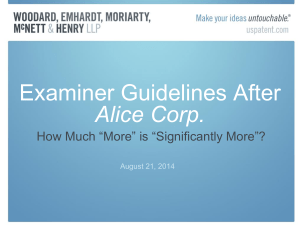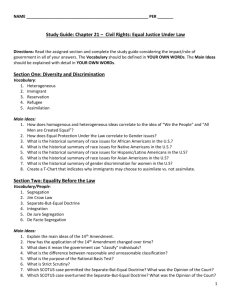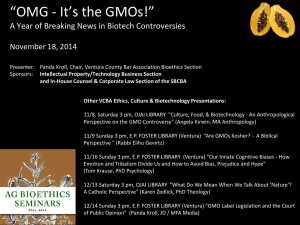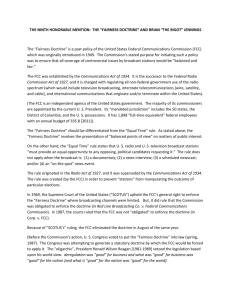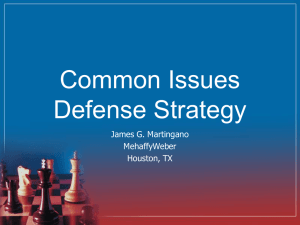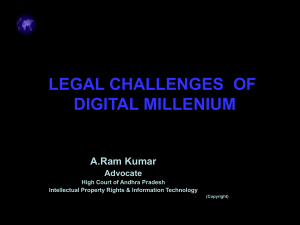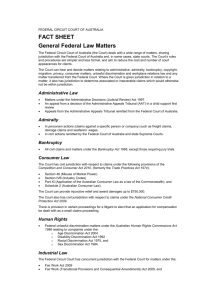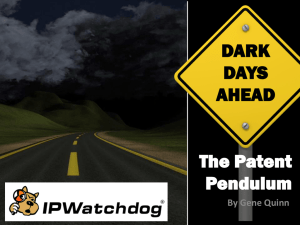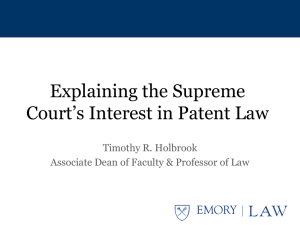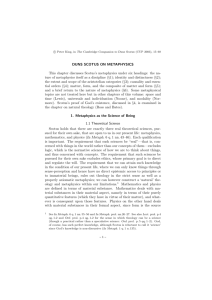due process - NYU School of Law
advertisement
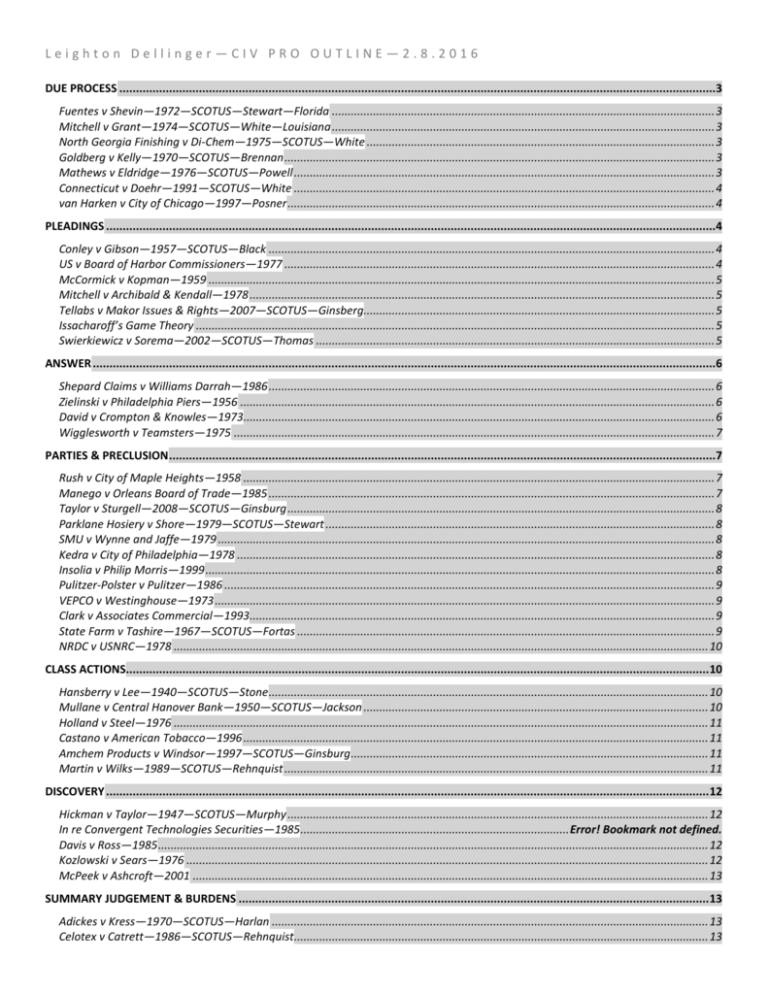
Leighton Dellinger—CIV PRO OUTLINE—2.8.2016 DUE PROCESS ....................................................................................................................................................................................3 Fuentes v Shevin—1972—SCOTUS—Stewart—Florida ......................................................................................................................... 3 Mitchell v Grant—1974—SCOTUS—White—Louisiana ......................................................................................................................... 3 North Georgia Finishing v Di-Chem—1975—SCOTUS—White .............................................................................................................. 3 Goldberg v Kelly—1970—SCOTUS—Brennan ........................................................................................................................................ 3 Mathews v Eldridge—1976—SCOTUS—Powell ..................................................................................................................................... 3 Connecticut v Doehr—1991—SCOTUS—White ..................................................................................................................................... 4 van Harken v City of Chicago—1997—Posner ....................................................................................................................................... 4 PLEADINGS ........................................................................................................................................................................................4 Conley v Gibson—1957—SCOTUS—Black ............................................................................................................................................. 4 US v Board of Harbor Commissioners—1977 ........................................................................................................................................ 4 McCormick v Kopman—1959 ................................................................................................................................................................ 5 Mitchell v Archibald & Kendall—1978 ................................................................................................................................................... 5 Tellabs v Makor Issues & Rights—2007—SCOTUS—Ginsberg............................................................................................................... 5 Issacharoff’s Game Theory .................................................................................................................................................................... 5 Swierkiewicz v Sorema—2002—SCOTUS—Thomas .............................................................................................................................. 5 ANSWER ............................................................................................................................................................................................6 Shepard Claims v Williams Darrah—1986 ............................................................................................................................................. 6 Zielinski v Philadelphia Piers—1956 ...................................................................................................................................................... 6 David v Crompton & Knowles—1973..................................................................................................................................................... 6 Wigglesworth v Teamsters—1975 ........................................................................................................................................................ 7 PARTIES & PRECLUSION .....................................................................................................................................................................7 Rush v City of Maple Heights—1958 ..................................................................................................................................................... 7 Manego v Orleans Board of Trade—1985 ............................................................................................................................................. 7 Taylor v Sturgell—2008—SCOTUS—Ginsburg ....................................................................................................................................... 8 Parklane Hosiery v Shore—1979—SCOTUS—Stewart ........................................................................................................................... 8 SMU v Wynne and Jaffe—1979 ............................................................................................................................................................. 8 Kedra v City of Philadelphia—1978 ....................................................................................................................................................... 8 Insolia v Philip Morris—1999 ................................................................................................................................................................. 8 Pulitzer-Polster v Pulitzer—1986 ........................................................................................................................................................... 9 VEPCO v Westinghouse—1973 .............................................................................................................................................................. 9 Clark v Associates Commercial—1993 ................................................................................................................................................... 9 State Farm v Tashire—1967—SCOTUS—Fortas .................................................................................................................................... 9 NRDC v USNRC—1978 ......................................................................................................................................................................... 10 CLASS ACTIONS................................................................................................................................................................................ 10 Hansberry v Lee—1940—SCOTUS—Stone ........................................................................................................................................... 10 Mullane v Central Hanover Bank—1950—SCOTUS—Jackson ............................................................................................................. 10 Holland v Steel—1976 ......................................................................................................................................................................... 11 Castano v American Tobacco—1996 ................................................................................................................................................... 11 Amchem Products v Windsor—1997—SCOTUS—Ginsburg ................................................................................................................. 11 Martin v Wilks—1989—SCOTUS—Rehnquist ...................................................................................................................................... 11 DISCOVERY ...................................................................................................................................................................................... 12 Hickman v Taylor—1947—SCOTUS—Murphy ..................................................................................................................................... 12 In re Convergent Technologies Securities—1985 ..................................................................................... Error! Bookmark not defined. Davis v Ross—1985 .............................................................................................................................................................................. 12 Kozlowski v Sears—1976 ..................................................................................................................................................................... 12 McPeek v Ashcroft—2001 ................................................................................................................................................................... 13 SUMMARY JUDGEMENT & BURDENS .............................................................................................................................................. 13 Adickes v Kress—1970—SCOTUS—Harlan .......................................................................................................................................... 13 Celotex v Catrett—1986—SCOTUS—Rehnquist................................................................................................................................... 13 Markman v Westview—1996—SCOTUS—Souter ................................................................................................................................ 14 Bell Atlantic v Twombly—2007—SCOTUS—Souter ............................................................................................................................. 14 PERSONAL JURISDICTION ................................................................................................................................................................ 14 Pennoyer v Neff—1877—SCOTUS—Field ............................................................................................................................................ 14 Hess v Pawloski—1927—SCOTUS—Butler .......................................................................................................................................... 14 International Shoe v Washington—1945—SCOTUS—Stone ............................................................................................................... 15 McGee v International Life—1957—SCOTUS—Black .......................................................................................................................... 15 Worldwide Volkswagen v Woodson—1980—SCOTUS—White ........................................................................................................... 15 Calder v Jones—1984—SCOTUS—Rehnquist ....................................................................................................................................... 15 Asahi v Superior Court—1987—SCOTUS—O’Connor........................................................................................................................... 15 Pavlovich v Superior Court—2002 ....................................................................................................................................................... 15 Burnham v Superior Court—1990—SCOTUS—Scalia .......................................................................................................................... 16 Helicopteros Nacionales de Colombia v Hall—1984—SCOTUS—Blackmun ........................................................................................ 17 SUBJECT MATTER & SUPPLEMENTAL JURISDICTION ........................................................................................................................ 17 Mas v Perry—1974 .............................................................................................................................................................................. 17 Nashville Railroad v Mottley—1908—SCOTUS—Moody ..................................................................................................................... 17 Grable v Darle—2005—SCOTUS—Souter ............................................................................................................................................ 18 United Mine Workers v Gibbs—1966—SCOTUS—Brennan—Supplemental ....................................................................................... 18 Owen Equipment v Kroger—1978—SCOTUS—Stewart—Supplemental ............................................................................................. 19 STATE & FEDERAL JURISDICTION ..................................................................................................................................................... 19 Swift v Tyson—1842—SCOTUS—Story ................................................................................................................................................ 19 Erie Railroad v Tompkins—1938—SCOTUS—Brandeis ........................................................................................................................ 19 Guaranty Trust v York—1945—SCOTUS—Frankfurter ........................................................................................................................ 19 Hanna v Plumer—1965—SCOTUS—Warren ....................................................................................................................................... 19 ATTORNEYS ..................................................................................................................................................................................... 20 Hickman v Taylor—1947—SCOTUS—Murphy ..................................................................................................................................... 20 Marek v Chesny—1985—SCOTUS—Burger ......................................................................................................................................... 20 Zuk v Eastern Pennsylvania Psychiatric Institute—1996 ..................................................................................................................... 20 Evans v Jeff D—1986—SCOTUS—Stevens ........................................................................................................................................... 20 2|Page Leighton Dellinger—CIV PRO OUTLINE—2.8.2016 DUE PROCESS Fuentes v Shevin—1972—SCOTUS—Stewart—Florida SHEVIN TOOK STOVE Florida replevin statute unconstitutional (lacking specific allegations, judge interaction, and damage for mistake) Dissent (White). In the interim period between purchase and transfer of ownership, the seizure of goods protects both parties equally. “The buyer loses use of the property temporarily…the seller is protected against deterioration of the property.” Mitchell v Grant—1974—SCOTUS—White—Louisiana GRANT TOOK STEREO Louisiana replevin statute constitutional (Required an affidavit from Grant—judicial review—bond—“immediate hearing and dissolution of writ”) North Georgia Finishing v Di-Chem—1975—SCOTUS—White NGF FROZE BANK ACCOUNT Georgia replevin statute constitutional “The most compelling deficiency in the Georgia procedure is its failure to provide a prompt and adequate post-garnishment hearing. WHITE’S CHECKLIST Specific allegations Bond Judge (not clerk) Post-seizure hearing Damages for mistaken writs CONSTITUTIONAL? Florida X √ X Unclear X NO Louisiana √ √ √ √ √ YES Georgia X X X X X NO Goldberg v Kelly—1970—SCOTUS—Brennan WELFARE BENEFITS Can’t take welfare benefits without a hearing Mathews v Eldridge—1976—SCOTUS—Powell DISABILITY BENEFITS Insufficient process to deprive Eldridge “Mathews depends upon competing interests and a general sense of how likely we are to get it wrong.”—S.I. Balancing Test: 1. “First, the private interest that will be affected by the official action; 2. Second, the risk of an erroneous deprivation of such interest through the procedures used, and the probable value, if any, of additional or substitute procedural safeguards; and 3. Finally, the government's interest, including the function involved and the fiscal and administrative burdens that the additional or substitute procedural requirement would entail.” 3|Page Leighton Dellinger—CIV PRO OUTLINE—2.8.2016 Connecticut v Doehr—1991—SCOTUS—White DOEHR’S HOME ATTACHED TO LITIGATION AFTER FIGHT WITH DIGIOVANNI Connecticut replevin statute unconstitutional Mathew’s Balancing Test: 1. Private Interest. Not total deprivation—attaches a lien but Doehr can still live in the house—LOW 2. Risk of Error. Use White’s checklist— a. Specific allegations—none. DiGiovanni is interested only in securing payment on tort—not interested in the house itself. b. Bond c. Judge. d. Post-seizure hearing. e. Damages/British-style litigation costs. 3. Public Interest. ONLY wielding governmental power for the benefit of DiGiovanni—LOW van Harken v City of Chicago—1997—Posner PARKING TICKETS Chicago’s procedures for reviewing parking tickets adequate—“The less that is at stake…the less process is due.” Mathew’s Balancing Test: 1. Private Interest. < $100—LOW 2. Risk of Error. Use White’s checklist—less process is an explicit goal—save cop time—save cost a. Specific allegations b. Bond c. Judge—“hearing officer” paid to conduct a “searching inquiry” d. Post-seizure hearing e. Damages/British-style litigation costs. 3. Public Interest—relatively small individually, interest in broad adjudication—LOW PLEADINGS Conley v Gibson—1957—SCOTUS—Black RAILROAD WORKERS DISCRIMINATION Rule 8(a)(2): “short and plain statement of the claim showing that the pleader is entitled to relief” “A complaint should not be dismissed for failure to state a claim unless it appears BEYOND DOUBT THAT A PLAINTIFF CAN PROVE NO SET OF FACTS IN SUPPORT OF HIS CLAIM which would entitle him to relief.” US v Board of Harbor Commissioners—1977 ALLEGED SICO/NASCO OIL SPILL SICO/NASCO claim it’s unfair that US can plead broadly—but: Efficiency: SICO/NASCO lowest cost providers of information Incentives: government doesn’t need to send in spies/ raid SICO/NASCO—better off just asking Fulfills goal of Rule 8: let’s US in the door cheap—facilitate modern litigation (rationalization the court chooses) 4|Page Leighton Dellinger—CIV PRO OUTLINE—2.8.2016 McCormick v Kopman—1959 DRAM SHOP McCormick allowed to plead in the alternative under Harbor Commissioners **Issacharoff: Court wrong. What is McCormick’s incentive to have an autopsy if she can pit Kopmann and Hul’s Tavern against one another? She is the cheapest cost provider of information under efficiency reading of Harbor Commissioners she should NOT be allowed to plead in the alternative. Mitchell v Archibald & Kendall—1978 NO CONSTRUCTIVE PREMESIS…EVEN FOR GRANDPA Mitchell—clearly claims that he was injured off the premises—instead of amending (to state a viable claim under Illinois law), appeals—effectively alternative pleading A&K—motion for 12(b)(6)—effectively alternative pleading no liability because Mitchell wasn’t on their premises—ALTERNATIVELY—if Illinois is going to allow him to sue under doctrine of constructive premises they deny liability Tellabs v Makor Issues & Rights—2007—SCOTUS—Ginsberg SECURITIES FRAUD = HIGHER PLEADING STANDARD Rule 9(b): “a party must state with particularity the circumstances constituting fraud or mistake” Particularity: claims specific enough to induce “an inference of scienter [that is] cogent (appealing forcibly to the mind or reason) and at least as compelling as any opposing inference of non-fraudulent intent.” **What would a reasonable person think? (NOT what could a reasonable person think?) EFFICIENCY: Elements of Fraud: 1. False or misleading statement Cheapest Cost Provider: Plaintiff 9(b) Pleading requirements: Specificity 2. Reliance upon statement Plaintiff Specificity Defendant Notice Pleading 3. Scienter Issacharoff’s Game Theory EVπ = Pπ × Aπ - costsπ EVΔ = (Pπ × Aπ + costsΔ) × -1 → when both sides use the same P settlement is ALWAYS advantageous to DEFENDANT before discovery costs Settlement: converge information on law [12(b)(6)] and fact [discovery] to equalize P and facilitate settlement In terrorum: settlement threat is disproportionate to the merit-based value of the case Swierkiewicz v Sorema—2002—SCOTUS—Thomas EMPLOYMENT DISCRIMINATION IN FAVOR OF FRENCH Thomas invokes the rules—Rule 8(a)(2) Notice Pleading in discrimination cases 5|Page Leighton Dellinger—CIV PRO OUTLINE—2.8.2016 ANSWER Shepard Claims v Williams Darrah—1986 LEGAL MALPRACTICE Darrah allowed to proceed on the merits DESPITE late answer and entry of default Darrah owed Shepard Claims money—Darrah’s attorney missed the deadline to answer the claim—entry of default could become a judgment of default (res judicata would attach) Darrah appeals Entry of Default. (Standard) Rule 55(c)—“The court may set aside an entry of default for good cause” “Good cause” determinates in United Coin Meter v Seaboard RR (1983) [essentially the same case]: 1. “Whether the default was willful (in this case—attorney negligence) 2. a set-aside would prejudice plaintiff, and (plaintiff has less of a chance to win on the merits) 3. the alleged defense was meritorious.” (“good at law w/o reference to the prob. of success”) Judgment of Default. (Rule) Rule 60(b)—relief from final judgment for the following reasons: 1. 2. 3. 4. 5. 6. Mistake, inadvertence, surprise, or excusable neglect; Newly discovered evidence… Fraud, misrepresentation, or misconduct by an opposing party; The judgment is void; The judgment has been satisfied, released, or discharged;… Any other reason that justifies relief. Zielinski v Philadelphia Piers—1956 FORKLIFT INJURY—SKETCHY ANSWER Defendants must affirm or deny each claim—even if they are poorly pleaded Zielinski’s claim can proceed Rule 10(b): “A party must state its claims or defenses in numbered paragraphs, each limited as far as practicable to a single set of circumstances.” Zielinski could have plead better Rule 8(b): (generally) PPI can’t profit by not being specific in their denials Use United Coin test—Can Zielinski bring suit even though statute of limitations has run? 1. “Whether the default was willful 2. a set-aside would prejudice plaintiff, and 3. the alleged defense was meritorious.” (absolutely. no other explanation. ) (absolutely, would lose the claim completely) (absolutely good at law) David v Crompton & Knowles—1973 PAPERSHREDDER C&K claim that they didn’t have sufficient information to admit/deny that they “designed, manufactured, and sold” machine—they knew Hunter did, but weren’t sure of terms of merger—deemed admitted, C&K can’t amend An answer can (on a claim-by-claim basis): Admit Deny Lack sufficient information denial UNLESS the defendant must/should know admission Can he amend? United Coin Test: Undue delay of denial? (Willful?) Yes—should have actively denied if they weren’t gaming Prejudicial? Absolutely—statute of limitations has run Meritorious defense? (not explicitly mentioned) Yes 6|Page Leighton Dellinger—CIV PRO OUTLINE—2.8.2016 Wigglesworth v Teamsters—1975 Rule 13(a)(1)(A): Compulsory counterclaim “arises out of the same transaction or occurrence” Teamsters counterclaim permissive NOT compulsory dismissed to state court. What do we learn from Wigglesworth? “Transaction or occurrence” is an imprecise standard The court forces countersuits into one proceeding for efficiency What you do in forum 1 (i.e. Teamsters in federal court) depends upon a range of future factors and may foreclose future options (i.e. if Teamsters filed later under State common law it could be precluded under res judicata) preclusion law **Issacharoff: Court wrong—effectively the same t/o Factual inquiry: what is Teamster’s claim? That W defamed them—what did Wigglesworth say? Everything that he claimed in W v T same t/o—court probably just acting to punish Teamsters PARTIES & PRECLUSION Preclusion: Claim Preclusion: Extinguishes entire case—forecloses litigation on any claims that were or should have been brought up—the “should have been” turns on the same transaction or occurrence test (usually set of facts or logical relationship, not technical legal claim. Test still murky.)—only forecloses for the exact parties involved, with Ginsberg’s exceptions as laid out in Taylor. (Rush, Manego) 1. How to raise claim preclusion. As an affirmative defense under Rule 8(c) 2. Standards. When does it apply? a. Same parties b. Same transaction or occurrence c. First case was resolved on merits d. First case was a final judgment 3. Exceptions. Change in law or fact. Issue Preclusion: same facts and the exact issues of fact have already been decided and were necessary to the disposition of the facts, but can apply to different parties. (Parklane) **can only be used against a party who has already has his day in court Rush v City of Maple Heights—1958 SEPARATE DAMAGE TO PERSON & PROPERTY (RUSH & MOTORCYCLE) Rush claim precluded—single cause of action—didn’t initially raise property damage—even though she won initially Manego v Orleans Board of Trade—1985 ROLLER RINK Manego’s racial discrimination case was dismissed for “vague allegations.” He was unable to bring antitrust claims against the same group because both sets of claims turned on the same facts. Claim Precluded. (even though he was calling the claim by a different name) 7|Page Leighton Dellinger—CIV PRO OUTLINE—2.8.2016 Taylor v Sturgell—2008—SCOTUS—Ginsburg ADEQUATE REPRESENTATION—MODEL AIRPLANE GUYS Remanded for consideration of Taylor and Herrick’s relationship Everyone gets his day in court except when claim preclusion attaches to a plaintiff who has: 1. agreed to be bound by the determination in an action between others (“test case”) 2. a “substantive legal relationship” with the first plaintiff (i.e. assignee/assignor, preceding landowners) 3. “adequate representation” in the first case 4. “assumed control” of the original litigation (e.g. subrogation) has already technically had his day in court 5. Agreed to be a designated representative (acting as an agent of the precluded party) 6. Been expressly foreclosed by “a special statutory scheme [which] may ‘expressly foreclose successive litigation by non-litigants…if the scheme is otherwise consistent with due process.” Parklane Hosiery v Shore—1979—SCOTUS—Stewart ISSUE PRECLUSION—SEC LITIGATION, PART II Shore was able to invoke issue preclusion against Parklane Hosiery to foreclose litigation on antitrust claims that were settled in the criminal case brought by the SEC. Rule limitations: Wait-and-see Plaintiffs can NOT invoke preclusion if Shore could have joined the earlier litigation he would not be able to invoke preclusion and Parklane Hosiery would not be estopped from litigating Unfairness to defendant—situations when there wasn’t an incentive to fully litigate the first claim Implications: defendants can win once and lose a million times over-litigation (Cortez Problem) SMU v Wynne and Jaffe—1979 RULE 10: NAMING PARTIES Could not include 4 unnamed women in the title of the lawsuit—had to name or drop them Rule 10(a): “the title of the complaint must name all parties”—LITIGATION FILTER Exceptions: “express congressional grant” or “compelling need to ‘protect privacy in a very private matter’” Kedra v City of Philadelphia—1978 RULE 20 (A): PERMISSIVE JOINDER OF PARTIES Could join claims against City officials because they were “reasonably related” Rule 20(a): Persons may be joined as defendants if the right to relief asserted against them “arises out of the same transaction, occurrence, or series of transactions or occurrences.” IF joined prejudice against City IF severed prejudice against Kedra **Genius: do discovery together, revisit severance motion, more facts NO PREJUDICE efficient and fair Insolia v Philip Morris—1999 RULE 20(A): PERMISSIVE JOINDER OF PARTIES Insolia must sever claims—most information for litigation already available, risk of prejudice to plaintiff is low, no efficiency gain to join parties (and try to do discovery together) can make Insolia sever AND reconcile with Kedra 8|Page Leighton Dellinger—CIV PRO OUTLINE—2.8.2016 Pulitzer-Polster v Pulitzer—1986 RULE 19: REQUIRED JOINDER OF PARTIES—NIECE V UNCLE Were Mom and Sister necessary parties? Rule 19—Joinder of Parties 19(a)—Required Parties. Super narrow—a party is only necessary if relief cannot be awarded in their absence → Cannot accord complete relief (indivisible damages) → Impair or impede the ability to protect their interest → Double, multiple, or otherwise inconsistent obligations → 19(b)—When Joinder is Not Feasible. MUCH broader—can dismiss or allow to proceed between the present parties “in equity and good conscience” Develop four-part test: 1. The plaintiff’s interest—Carol has basically the same claims in state court low 2. The defendant’s interest—Uncle Samuel is defending this same case, efficiency gain high 3. The absentees’ interest—Mom and sister would be precluded in state court by a judgment for Carol in federal court—FALSE. (Issacharoff thinks the court got this wrong) 4. The public interest—waste of judicial resources to try the same claims in two courts, efficiency high Carol cannot bring this federal claim in equity and good conscience—dismissed under Rule 19(b) VEPCO v Westinghouse—1973 RULE 17: REAL PARY IN INTEREST (INSURANCE COMPANY) If insurers subrogate litigation AND explicitly agree to attach res judicata the suit can proceed in another name Rule 17—“An action must be prosecuted by the real party in interest” Why can VEPCO sue in INA’s stead? Because res judicata will attach serves “modern function” of Rule 17— protecting defendants from multiple litigation Clark v Associates Commercial—1993 RULE 14: IMPLEADER—THE THUGS AND THE TRACTOR Impleader—apportionment device—to the extent that Associates is liable to Clark the thugs are (or could be) derivatively liable to Associates Rule 14: may serve a complaint on a third party who is or may be liable to it for all or part of the claim against it— allows the suit to go forward without leaving Clark holding the bag waiting to re-litigate against Associates *do NOT use impleader as a defense—if third party is independently liable raise the facts to support alternate theory of liability Note 3. The Car Accident. 1. 14(a)—i.e. to the extent that B is liable to A, C is liable to B at least in part (impleading, not original plaintiff) 2. 14(b)—i.e. to the extent that A is liable to B, D is liable to A at least in part (impleading, original plaintiff) 3. 13(a)—i.e. A is liable to B (compulsory counterclaim) 4. 18(a)—i.e. C is liable to B (stand-alone claim) 9|Page Leighton Dellinger—CIV PRO OUTLINE—2.8.2016 State Farm v Tashire—1967—SCOTUS—Fortas RULE 22: INTERPLEADER—BUS ACCIDENT 28 USC 1335: DON’T WORRY ABOUT DIVERSITY ACROSS THE V— >$500 State Farm can use interpleader (Rule 22) because they have a FIXED POT (“WOULD BE EXPOSED TO DOUBLE OR MULTIPLE LIABILITY) would protect against a race to the available damages—BUT the $20,000 is too small a tail to “wag the dog” the bulk of the litigation would be inappropriate in Oregon because it would be unfair National Resource Defense Counsel v US Nuclear Regulatory Commission—1978 RULE 24: INTERVENTION NRDC wants to enjoin NRC granting licenses. Can United Nuclear (already granted a license), AMC and Kerr-McGee (pending license applications) intervene? Three part test in Rule 24: 1. Do they have a significant interest? 2. Could they be impaired by the decision if excluded? 3. Are they already adequately represented? → ALL PARTIES ALLOWED TO INTERVENE CLASS ACTIONS Rule 23. a) Prerequisites. 1) Numerosity 2) Common questions of law or fact 3) Typicality 4) Adequate representation b) Types. 1) To avoid individual judgments and: inconsistency, impairing/impeding absent parties’ interest 2) Acting/refusing to act on grounds that apply generally to a class—Brown v Board OR limited pot (essentially plaintiff’s interpleader) 3) Questions of law/fact SO common that a class action would be superior—Celotex c) Define the class. Hansberry v Lee—1940—SCOTUS—Stone Generally: “One is not bound by a judgment in personum in a litigation in which he is not designated as a party or to which he has not been made a party by service or process.” Exception: Class Actions UNLESS they are adequately represented or their interests align Hansberry’s NOT adequately represented by Klieman--would mean that transferring dead created new interest (struck down for inadequate representation NOT being contrary to public policy—right decision, poor rationale) Mullane v Central Hanover Bank—1950—SCOTUS—Jackson Requires notice to plaintiffs represented by class despite super small interest in the case and relatively expensive (prohibitive) costs to communicate effective notice. Issacharoff—“I like this case because it’s extreme”—cheaply gather plaintiffs for VERY small claims class action as mechanism for fairness and accountability within the legal system. 10 | P a g e Leighton Dellinger—CIV PRO OUTLINE—2.8.2016 Holland v Steel—1976 GEORGIA PRISONERS—CERTIFICATION GRANTED We can certify a class of imaginary plaintiffs IF we are dealing with injunctive relief **Keep in mind that we may preclude future litigants (could he NOT be precluded because he wasn’t served notice and given the option to opt-out of the class? Or were these waived because he was necessarily an imaginary future plaintiff?)—HUGE IMPLICATIONS Castano v American Tobacco—1996 CERTIFICATION NOT GRANTED “The most compelling rationale for finding superiority in a class action--the existence of a negative value suit--is missing in this case.” Think back to the 4 part test: 2. Common issues of fact or law: Varying state laws—varying individual facts—different standards of negligence → no efficiency gains—no transactional savings because the court is still unfamiliar with the immature cases Amchem Products v Windsor—1997—SCOTUS—Ginsburg SETTLEMENT CERTIFICATION NOT GRANTED Reach a settlement for “inventory” cases—asbestos defendants won’t settle without precluding future plaintiffs Not adequately represented “no structural assurance” that future claimants would be represented Common issues not predominant (can’t know which issues would dominate future claimants) Dissent—Breyer—it’s important to get A settlement and sometimes that means you have to take less Martin v Wilks—1989—SCOTUS—Rehnquist BLACK FIREFIGHTERS The white firefighters were not sufficiently represented in the first lawsuit could not be barred from day in court **We don’t want de facto class actions by barring absent parties with aligned goals (no notice, no opt-out) Collateral Challenge. A or B can categorically challenge after appeals are exhausted for: corruption, duress, fraud, collusion, or mistake OR lack of subject matter jurisdiction. (necessarily more strenuous than appellate process) 11 | P a g e Leighton Dellinger—CIV PRO OUTLINE—2.8.2016 DISCOVERY 1. Hickman v Taylor—1947—SCOTUS—Murphy Notice Pleading more rigorous discovery—“mutual knowledge of all the relevant facts gathered by both parties is essential to proper litigation” 2. Problems. No mutually assured deterrence. Assumes parties don’t ask for what they don’t need to avoid “tit for tat” escalation—Rule: “information sought is of sufficient potential significance to justify the burden the discovery probe would impose” PROBLEMS: Asymmetric information strategic abuses emerge. RISK and COSTS are different between parties: a. Davis v Ross—1985 Davis wants info on Ross’ net worth—could injure Ross in other litigation—no proper retaliation b. Coca-Cola Bottling v Coca Cola—1985 Bottlers want secret formula for Coke and Diet Coke—court deems them ‘relevant’ to litigation orders Coke to hand them over—capitulates to extortion rather than share their trade secret c. In re Convergent Technologies—1985 How can we manage this information ‘market failure’? general response, regulation—by not regulating on a case-by-case basis we invite willful misconduct, Ross, and Coca Cola Bottling—bullying and extortion 3. Moral Hazard. Parties don’t internalize costs—it’s cheaper to ask than to produce—no incentive to weigh the marginal benefit of production— Δs generally have more info repeat Δ want more strict discovery and repeat π want more liberal discovery CONSEQUENCES—excessively expensive because we can’t tailor the litigation to cases. Increasingly, people optout of the public forum for private Alternate Dispute Resolution (ADR) or public small claims court → → Mediation facilitates negotiation Arbitration renders judgment Who pursues ADR? The most wealthy litigants lose interest in public dispute forum Necessarily parasitic—generates opinions and novel changes that the rest of the legal community can’t prospectively use Kozlowski v Sears—1976 FLAMMABLE PAJAMAS Sears has to produce records If defendant is in control of the records AND plaintiff has a reasonable need of them then defendant must produce the records and cannot benefit from a system that makes it “unduly difficult to identify or locate them, thus rendering the production of the documents an excessively burdensome and costly expedition” Should we require Sears to keep this kind of information? Yes—just the cost of doing business 12 | P a g e Leighton Dellinger—CIV PRO OUTLINE—2.8.2016 McPeek v Ashcroft—2001 DOJ BACK-UP TAPES Test run Balancing test—decide to do a test run to reconstruct the backup tapes most likely to have information—onerous process but a test run allows them to see what they might find AFTER having looked through the original files and other places and not turning anything up SUMMARY JUDGMENT & BURDENS Rule 50. Judgment as a Matter of Law. Granted if a party has been fully heard on an issue and reasonable jury would not have a legally sufficient evidentiary basis to find for the party on that issue. Rule 56. Summary Judgment. Burden of Proof—always on the movant (plaintiff in case; movant in motion) Burden of Production—shifts Adickes v Kress—1970—SCOTUS—Harlan FREEDOM RIDERS—SUMMARY JUDGMENT NOT GRANTED Kress motions for summary judgment fails because he failed to meet the shifted burden of production—greater than the defendant’s burden at trial (0) Kress motions for SJ—indicates that Adickes hasn’t sufficiently established that there was a conspiracy (BOProd) Adickes—originally claimed that police were in store ( indicative of conspiracy) (BOProd) Kress—FAILED TO “FORECLOSE THE POSSIBILITY THAT THERE WAS A CONSPIRACY” **Issacharoff—this was the wrong decision because the shifted BOProd is greater than the BOProof + there is an inherent logical difficulty in proving a negative **Implications—eviscerates summary judgment by making BOProd on defendant too onerous Celotex v Catrett—1986—SCOTUS—Rehnquist THE COURT HELD THAT THE MANUFACTURER WAS ENTITLED TO SUMMARY JUDGMENT BECAUSE THE RECORD DID NOT CONTAIN SUFFICIENT EVIDENCE TO CREATE A GENUINE ISSUE OF MATERIAL FACT WITH RESPECT TO THE DECEDENT'S EXPOSURE TO THE PARTICULAR ASBESTOS PRODUCT. Celotex motions for SJ—indicates that Catrett hasn’t sufficiently established exposure to asbestos (BOProd) Catrett—originally claimed that husband had mesothelioma and was exposed (BOProd) Celotex—COURT DECLINED TO EXAMINE CELOTEX EVIDENCE—BOPROD = BOPROOF—TOO ONEROUS **Implications—SJ becomes a back-end screen for liberal notice pleadings—get in easy—liberal discovery—court can dismiss claims without burdening defendant (more than they would at trial) **Dissent—Brennan—we should require something of defendant—maybe prove that within the universe of witnesses/interrogatories there is no evidence—more onerous than trial, but get out early on SJ BOProof BOProd Adickes Movant 100% (effectively BOProof) Currie (Rehnquist maj. in Celotex) Movant 0% IF Δ is movant and ult. BOProff is 0—should equal BOProof 13 | P a g e Leighton Dellinger—CIV PRO OUTLINE—2.8.2016 Louis (Brennan dissent in Celotex) Movant 50% Not conclusively just no factual predicate for claim Matsushita v Zenith—1986—SCOTUS—Powell IN THE ABSENCE OF ANY EVIDENCE THAT PETITIONERS CONSPIRED TO PRICE PREDATORILY DESPITE THE LACK OF ANY APPARENT MOTIVE TO DO SO, THE COURT INSTRUCTED THAT MATSUSHITA WAS ENTITLED TO SUMMARY JUDGMENT. Predatory pricing—though allegations were properly supported, the court found one side’s expert witness more plausible than the other’s—granted summary judgment—RADICAL—INVITES THE COURT TO WEIGH FACTS. Anderson v Liberty Lobby—1986—SCOTUS—White “ONLY DISPUTES OVER FACTS THAT MIGHT AFFECT THE OUTCOME OF THE SUIT…WILL PROPERLY PRECLUDE THE ENTRY OF SUMMARY JUDGMENT. Factual disputes that are irrelevant or unnecessary will not be counted.” Markman v Westview—1996—SCOTUS—Souter DRY CLEANERS DEFINITIONS Markman claimed infringement—jury agreed—judge did not—dismissed on summary judgment Let a judge decide which is the proper definition of “inventory”—predicated on “special training in exegesis” Who can conduct this factual inquiry? Souter saw this as a unique patent situation—expansive implications? Bell Atlantic v Twombly—2007—SCOTUS—Souter Twombly’s claim dismissed on 12(b)(6) Alleged conspiracy (parallel action + agreement)— facts presented could support the finding of an agreement—court found them implausible— dismissed claim ON THE FACTS for efficiency—unlikely to find sufficient evidence of conspiracy to justify the costs of discovery given asymmetric information when could someone claim conspiracy/fraud (would necessarily not have all the information—only indicia like what we see in Twombly’s claim)? PERSONAL JURISDICTION Pennoyer v Neff—1877—SCOTUS—Field COMMON LAW JURISDICTION Sources of Personal Jurisdiction: 1. Domiciliary 2. In-state service 3. Consent Challenges: automobile—corporation—globalization/the Internet Hess v Pawloski—1927—SCOTUS—Butler CAR ACCIDENT IN MASSACHUSETTS—JURISDICTION AFFIRMED Hess sues Pawloski in Massachusetts—in-state service by sending a copy certified and actually serving his “agent”, the secretary of state—we accept this legal fiction to facilitate interstate travel → Still trying to fit within the Pennoyer constructs 14 | P a g e Leighton Dellinger—CIV PRO OUTLINE—2.8.2016 International Shoe v Washington—1945—SCOTUS—Stone TRANSACTIONALLY-BASED JURISDICTION Two-part test: 1. Minimum contacts—flow of products “neither irregular nor casual”—TRANSACTIONALLY RELATED to suit a. No continuous/systematic contact with forum b. No office c. No bank accounts/commercial presence d. No license e. No personnel/employees 2. Traditional notions of fair play and substantial justice McGee v International Life—1957—SCOTUS—Black INSURANCE PREMIUM IN CALIFORNIA—JURISDICTION AFFIRMED → Sufficient Minimum Contacts. One continuous client sufficient minimum contact to assert personal jurisdiction in California purposeful availing of California laws/benefits → Texas Courts. Eviscerates “fair play and substantial justice” Political Economy. NO incentive for elected judges to deny jurisdiction to constituents in favor of out-ofstate corporations—inefficient to try cases and vacate later for lacking jurisdiction Doctrine. Worldwide Volkswagen v Woodson—1980—SCOTUS—White CAR ACCIDENT IN OKLAHOMA—NO JURISDICTION ENTIRELY A DEFENDANT-BASED INQUIRY: (DOESN’T ADDRESS IF PLAINTIFF LIVED IN OKLAHOMA) Foreseeability—WWV couldn’t reasonably anticipate that stream of commerce would extend this far— chattel-driven movement is insufficient to constitute sufficient minimum contact Balance—did WWV enjoy the benefits of Oklahoma laws/take advantage of the market in their forum? NO DISSENT (Brennan): “by its very design & purpose so mobile that petitioners can foresee its possible use in Oklahoma” CONCERNS POST-WORLDWIDE VOLKSWAGEN: Plaintiff interest in a particular forum—what if the π had lived in Oklahoma and just bought car in NY? Comparative evaluation of fora—what if the case could be heard in different states? Multiple regulators—Tennessee imposing its community morals on the country—France sanctioning Yahoo! sales in America—West Virginia and punitive automobile class actions Calder v Jones—1984—SCOTUS—Rehnquist HUSTLER MAGAZINE—CALIFORNIA JURISDICTION UPHELD LOOKS PAST DEFENDANT-BASED INQUIRY. → “Focus of the injury”—Hustler is in California—most of the harm to Jones is in California Pavlovich v Superior Court—2002 DVD SOFTWARE—INTERNET—CALIFORNIA JURISDICTION VACATED Rejects “Focus of the injury”—knowledge of the central (geo) place of harm is insufficient to confer p.j. “Communication by a universally accessible Internet website cannot be equated with “express aiming” at the entire world” **IF JONES IS RIGHT, PAVOLOVICH MUST BE WRONG** 15 | P a g e Leighton Dellinger—CIV PRO OUTLINE—2.8.2016 Asahi v Superior Court—1987—SCOTUS—O’Connor MOST SIGNIFICANT MODERN CASE SHIFTS TO INCLUDE A PLAINTIFF INQUIRY CRUX OF DECISION—Fair play and substantial justice balancing test—essentially Matthews: 1. Burden on the defendant. 2. Interests of the forum state. 3. Plaintiff’s interest in obtaining relief in the forum state. 4. Overall systemic efficiency. Look at pending litigation costs If Zurcher is still in: 1. Very high—look to comparables—International Shoe: “systematic and continuous”—Worldwide Volkswagen: “direct sales; property; agents; targeted design; advertising) 2. High—exercise sovereignty to protect its citizens 3. Medium—wants the whole chain of accountability in here. 4. What happened at the accident will drive the inquiry is essentially a question best asked in CA PERSONAL JURISDICTION AFFIRMED After Zurcher settles out: 1. “Severe” Taiwan California—REMAINS UNCHANGED 2. “Slight”—“all that remains is a claim for indemnification asserted by Cheng Shin, a Taiwanese corporation, against Asahi—don’t look to non-merits based predications (ie 3. “Considerably diminished” NOT a California plaintiff—wouldn’t be the most efficient way to enforce corrective justice vs. Asahi—their distributors are sufficiently significant 4. Low. No outstanding factors make California a better forum than any other place. PERSONAL JURISDICTION DENIED The Justices. BRENNAN—minimum contact is necessary and sufficient for personal jurisdiction no need for balancing test O’CONNOR—Mathews-style balancing test to define “fair play and substantial justice” STEVENS—sufficient minimum contact because still in stream of commerce, but jurisdiction vacated for fp&sj Shaffer v Heitner—1977—SCOTUS—Marshall STOCK CERTIFICATES IN DELAWARE Delaware jurisdiction vacated—stock certificates insufficient minimum contacts to warrant jurisdiction Dicta: “ALL assertions of…jurisdiction must be evaluated according to the standards set forth in International Shoe” Burnham v Superior Court—1990—SCOTUS—Scalia DAD VISITS KIDS IN CALIFORNIA No challenge to jurisdiction if there is in-state service. Ever. Scalia and originalism—Pennoyer still good law (but consent is questioned in cases like Carnival Cruise Line) Dissent—Brennan—uses Asahi 4-part balancing test BUT says that anyone within the state (even for only 3 days) has necessarily purposefully availed himself of the benefits of the jurisdiction state has a high interest in exercising jurisdiction WILL ALWAYS FIND JURISDICTION Issacharoff: who has the dumbest opinion in this case? 16 | P a g e Leighton Dellinger—CIV PRO OUTLINE—2.8.2016 Helicopteros Nacionales de Colombia v Hall—1984—SCOTUS—Blackmun GENERAL JURISDICTION Can Helicopteros be sued for ANYTHING in the forum (Texas)? If they have minimum contacts as a corporation (not predicated on this transaction)—did claims ‘arise out of’ and are related to activities in Texas?—O’Connor’s list from Asahi IIA— 1. No continuous/systematic contact with forum 2. No office 3. No bank accounts/commercial presence 4. No license 5. No personnel/employees NO GENERAL JURISDICTION SUBJECT MATTER & SUPPLEMENTAL JURISDICTION Is this the right court to entertain this cause of action? Mas v Perry—1974 MISSISSIPPI GIRL IN LOUISIANA GRADUATE SCHOOL MARRIES FRENCHMAN 28 USC 1332—complete diversity and amount in controversy > $75,000 1. How do we determine AMOUNT IN CONTROVERSY? Ex ante assessment—could the court reasonably award $75,000 or more? 2. How do we define DOMICILE? Residence in a state with an intention to remain indefinitely Nashville Railroad v Mottley—1908—SCOTUS—Moody RAILROAD PASSES REVOKED BY CONGRESS 28 USC 1331—federal question must arise on the face of the complaint 3. Is a federal question present on the FACE OF THE CLAIM? cannot anticipate an federally grounded answer Well-plead complaint rule 17 | P a g e Leighton Dellinger—CIV PRO OUTLINE—2.8.2016 Merrell Dow Pharmaceuticals v Thompson—1986—SCOTUS—Stevens Thompson wanted their failure to warn tort claim in state court—MD removed on federal question because labeling standards are governed by federal regulatory rule Remanded to state forum because “The mere presence of a federal issue in a state cause of action does not automatically confer federal question jurisdiction.” 1. Protect the integrity of state law/state court adjudications 4. What does it mean to “ARISE UNDER”? a. Express cause of action—Holmes b. Implied cause of action i. Is the plaintiff within the contemplation of the statute? ii. Legislative intent? iii. Would a private right of action further the purpose of the statute iv. Traditional remedies under state law? c. Federal ingredient—effectively folded into implied cause of action by Grable i. Raise a federal issue? ii. Is the federal issue actually disputed and substantial? iii. Can the federal issue be entertained without disturbing the state-federal balance? Grable v Darue—2005—SCOTUS—Souter QUITCLAIM DEED TRANSFERRED WITHOUT PROPER NOTICE UNDER A FEDERAL STATUTE Does the state law action against the new owner of the property raise a federal claim sufficient to warrant federal jurisdiction? Yes—but draws the line at “congressional intent” looks a lot like implied cause of action (1) state law claim necessarily raises a federal issue; (2) federal issue is actually disputed; (3) federal issue is substantial; and (4) which a federal forum may entertain without disturbing any congressionally approved balance of federal and state judicial responsibilities. SUPPLEMENTAL JURISDICTION Pendant (over-lapping law—claims sufficiently related to federal claims)—Gibbs Ancillary (over-lapping fact—claims between non-diverse parties in a single t/o already in federal court) United Mine Workers v Gibbs—1966—SCOTUS—Brennan 28 USC § 1367(A)—STATUTORILY CODIFIES If plaintiff brings BOTH A STATE (tort) and FEDERAL (secondary boycott) claim it can go to federal court IF: 1. one constitutional case 2. substantial federal issue 3. transactionally related 4. state law issues don’t predominate Gibbs allowed to bring claims together to promote “judicial economy, convenience, and fairness to litigants” 18 | P a g e Leighton Dellinger—CIV PRO OUTLINE—2.8.2016 Owen Equipment v Kroger—1978—SCOTUS—Stewart KROGER (IOWA) V OPPD (KANSAS) V OWEN (ORIGINALLY KANSAS IOWA) ALIGNING INCENTIVES (FOR FIRST ACTORS) 1. Only a question of state law State court 2. State and federal claims Either—but limited to federal predominance 28 USC 1367(b) 3. Diversity (only reason for getting into federal) Leave all state claims in state court 4. Defendants Bring in whomever/whatever you want BUT FOR diversity in the first case Kroger wouldn’t be in federal court subject matter jurisdiction vacated Zahn v International Paper—1973—SCOTUS—White CANNOT AGGREGATE CLAIMS TO EXCEED THE AMOUNT IN CONTROVERSY REQUIREMENT OF DIVERSITY JURISDICTION STATE & FEDERAL JURISDICTION Swift v Tyson—142—SCOTUS—Story Erie Railroad v Tompkins—1938—SCOTUS—Brandeis Guaranty Trust v York—1945—SCOTUS—Frankfurter Hanna v Plumer—1965—SCOTUS—Warren Yes--> Yes --> Is the state rule within the Rules Enabling Act? Yes --> If you can satisfy both the state and federal rules without an opeartional conflict FEDERAL RULE CONTROLS No --> This would mean that the Rules Enabling Act was wrong--NEVER HAPPENS--collapses--FEDERAL RULE CONTROLS Do the federal and state rules conflict? No --> FEDERAL RULE CONTROLS Is there a federal rule on point? Avoid forum shopping No --> Look to Twin Aims of Erie: equal protection and administration of the law 19 | P a g e Leighton Dellinger—CIV PRO OUTLINE—2.8.2016 ATTORNEYS Hickman v Taylor—1947—SCOTUS—Murphy Marek v Chesny—1985—SCOTUS—Burger Zuk v Eastern Pennsylvania Psychiatric Institute—1996 Evans v Jeff D—1986—SCOTUS—Stevens 20 | P a g e Leighton Dellinger—CIV PRO OUTLINE—2.8.2016
